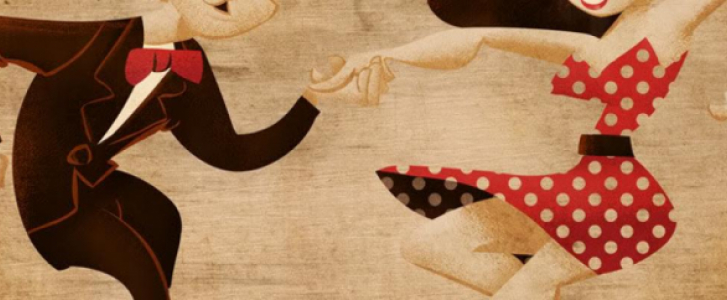West Coast Swing is a partner dance with roots in the Lindy Hop. It is characterized by an elastic look that results from its extension-compression technique of partner connection and is danced primarily in a slotted area on the dance floor. The dance allows for both partners to improvise steps while dancing together, putting West Coast Swing in a short list of dances that emphasize improvisation.
Typically the follower walks into new patterns traveling forward on counts "1" and "2" of each basic pattern, rather than rocking back. Traditional figures include 6-count and 8-count patterns of one of the four basic varieties: (1) Starter Step, (2) Side Pass, (3) Push Break / Sugar Push, (4) Whip.
Alternatively the basic patterns in West Coast Swing are defined as: Sugar Push; Left Side Pass; Right Side Pass; Tuck Turn; and Whip. Virtually all other moves in West Coast Swing are variations of these basic patterns.
The Anchor Step is a common ending pattern of many West Coast Swing figures.
The origins of the West Coast Swing are in the Lindy Hop. In a 1947 book, Arthur Murray wrote, "There are hundreds of regional dances of the Jitterbug type. Each section of the country seems to have a variation of its own."
Dean Collins, who arrived in the Los Angeles area around 1937, was influential in developing the style of swing dance on the West Coast of the United States as both a performer and teacher. When his wife, Mary Collins, was asked if Dean was responsible for the emergence of the dance, however, she said that Dean insisted there were "only two kinds of swing dance—good and bad". According to one of his former students, a member of his last dance troupe, Collins himself said that he had nothing to do with the West Coast Swing style.
Laure Haile, an Arthur Murray National Dance Director documented swing dancing in Los Angeles and used the name "Western Swing".
Western swing, country boogie, and, with a smaller audience, jump blues were popular on the West Coast throughout the 1940s and into the 1950s when they were renamed and marketed as rock and roll in 1954. Dancers danced "a 'swingier' more smooth and subdued" form of jitterbug to Western swing music.
West Coast Swing (still known as Western Swing at that time) is the basis for the dancing in the rehearsal scene in Hot Rod Gang (1958). Music is supplied by rockabilly musician Gene Vincent's "Dance to the Bop".
Murray taught Western Swing beginning from a closed position and the possibility of dancing single, double, or triple rhythm. After "Throwout" patterns began with the woman "walking in" and the man doing a "rock step", or step together for counts one and two. Although the dance remained basically the same, the Golden State Dance Teachers Association (GSDTA) began teaching from the walk steps, counts 1 and 2. It replaced Laure Haile's Coaster Step with an "Anchor Step" around 1961.
"West Coast swing" as a synonym for "Western swing" appears in a 1961 dance book, and was used in an advertisement by Skippy Blair in 1962 but wasn't incorporated into mainstream swing circles until the late 1960s.
Blair credits Jim Bannister, editor of the Herald American newspaper in Downey, California, for suggesting the name West Coast Swing.
In her 1994 book Dance Terminology Notebook, Blair wrote she would "tell anyone who would listen, that Western really meant West Coast. One of the students made an asture observation and asked, 'Then why don't you say that?'"
When the Golden West Ballroom, in Norwalk, California, changed from Country to Ballroom dancing, the dance most advertised on the Marquee was West Coast Swing.
"Beginning with the 1967 opening of the Golden West Ballroom in Norwalk, California, and through 1980, West Coast Swing was on the marquee as the dance taught every Wednesday and Friday night."
New Era in the Presentation of Country Music Showplace to Feature Top Singing Stars. Author: Ron Heinzel. Los Angeles Times. Date: December 1, 1963 Start Page: OCA2 Pages: 2 Section: Orange County "On the night of December 5 the doors will swing open at the Golden West Auditorium to mark the realization of a dream and an era in the presentation of music Americana.
Golden West Auditorium, a new country music show place located at 12400 Studebaker Road at Imperial Highway, Norwalk, Calif., celebrated its formal opening with a press party embracing cocktails, lunch and a fashion show December 2. The new country music auditorium is the realization of an idea nurtured some five years ago by businessman Olen S. Thidedeau, who vowed to give Southern California a country music show place second to none. Billboard December 14, 1963 page 20
Western Swing was documented in the 1971 edition of the "Encyclopedia of Social Dance". Patterns began with the woman stepping forward twice, but described the "Coaster Step" with a forward step as the last step of the 2nd triple. The one song that was listed for this dance was "Comin' On" by Bill Black's Combo (1964 Hi #2072). As late as 1978, the term "Western Swing" was common usage among Chain and Independent Studios to describe "slotted swing".
Circa 1978 "California Swing" was yet another name for West Coast Swing, albeit with styling that was "considered more UP, with a more Contemporary flavor." By 1978 GSDTA had "some 200 or more patterns and variations" for West Coast Swing."
In 1988, West Coast Swing was pronounced the Official State Dance of California.
Source: Wikipedia
